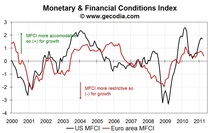
Our measures of monetary and financial conditions for both the USA and Europe* show that since the beginning of this year the overall environment is clearly more restrictive in the euro area than in the US. In the end of 2010, the two MFCI were close.
This change is primarily linked to the global appreciation of the euro and a more rapid rebound in M2 growth in the US (thanks to quantitative easing). Note that in both countries, a rise in corporate and in sovereign yields over the last quarters.
As the ECB decided in April to engage itself in a tightening cycle (+0.25% for the refi rate at 1.25%), this will widen the gap between the US and the euro area.
Economic Impacts
Future hikes in the refi rate will have negative direct and indirect (via euro appreciation and rise in long term yields) impacts on the already weak euro area GDP growth. This should lead the ECB to adopt a prudent path for monetary tightening and only hike every two months. More on that next thursday.
* Our index for monetary and financial conditions aggregates data coming from financial markets (equities, real exchange rate, sovereign and corporate yields) and from monetary supply (interest rate, M2). We use headline inflation for calculate data in real terms. Overall index is normalized.
This change is primarily linked to the global appreciation of the euro and a more rapid rebound in M2 growth in the US (thanks to quantitative easing). Note that in both countries, a rise in corporate and in sovereign yields over the last quarters.
As the ECB decided in April to engage itself in a tightening cycle (+0.25% for the refi rate at 1.25%), this will widen the gap between the US and the euro area.
Economic Impacts
Future hikes in the refi rate will have negative direct and indirect (via euro appreciation and rise in long term yields) impacts on the already weak euro area GDP growth. This should lead the ECB to adopt a prudent path for monetary tightening and only hike every two months. More on that next thursday.
* Our index for monetary and financial conditions aggregates data coming from financial markets (equities, real exchange rate, sovereign and corporate yields) and from monetary supply (interest rate, M2). We use headline inflation for calculate data in real terms. Overall index is normalized.
 World GDP
World GDP



